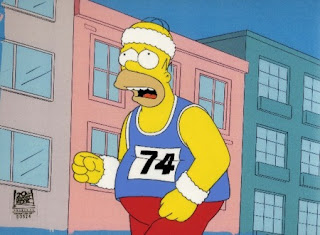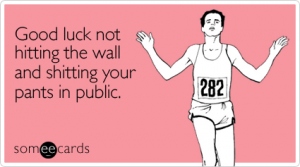
Either way, this feeling was starting to overwhelm me this week. It certainly didn't help that I was in the middle of an extremely stressful work week. I have the nasty habit of assuming everything will go wrong if just one thing does. And trust me, plenty of things went wrong at work this week. Which in my head meant my marathon - three weeks away, mind you - would also go wrong.
At the start of this training block, I ran a local 5K in 29:56. I ran the first mile way too fast and blew up the last two. I was devastated. I had run two minutes off my 5K PR and had felt like dying the whole time. Admittedly, I lost a ton of fitness between being sick twice and injured once leading up to Crossroads, but I hadn't realized how bad it was. I think I tricked myself into believing I had lost my endurance and not my speed, even though I'm perfectly aware that speed disappears first.

However, I decided a 4:20 was an achievable marathon goal. I spent all summer training with these times, but after avoiding a couple of long runs because I subconsciously realized I wouldn't hit the prescribed pace, I updated it to 4:30, and I've been feeling much better about those times.
But then I started to get nervous. Other than the disastrous 29:56, I had no recent race time to help me predict my marathon finish time. When I started drawing up a race plan for Monument, I realized I was mostly guessing at how fast I thought I could run, without any real evidence to base my assumptions on. Combine that with the antsy feeling, and I decided a 5K was in order.
I briefly contemplated running a 5K in my area this weekend, but I didn't want anything cutting into football time and didn't feel like paying through the nose since early registration would be long over. Since the anxiety was starting to get distracting at work and hurting my quality of sleep, I decided to replace my Thursday tempo run with a simulated 5K.
 |
| According to Google Images, this is what I did. |
My heart rate was already elevated even after the slow mile, mostly from nerves. I stopped to switch my podcast over to music and then took off. I decided to do at least the first half mile on feel and check in at that point. I was shocked after .5 miles to see I was running a little over 9 min/miles.
That was about how fast the first mile of that fateful 5K had been three months ago, and I was worried a similar explosion was ahead for me. But I decided to forge on. I promised myself if I needed to slow down, I would. Spoiler alert, I didn't.

The first mile, while slightly uncomfortable, was quite doable. It was the second mile where everything started to hurt. This mile is always mentally hard for me, but I always try to tell myself that once it's done, only one mile remains. I backed off a tiny bit to save some gas for that last push, so I was shocked to see I was only two seconds behind the first mile.
At this point, I was hurting pretty bad. I wanted to throw in the towel, but I knew I had to finish. Surprisingly, this was the only spot where I missed running an actual race. I think it's easier to push through this mental block when I'm surrounded by other people. This mile ended up being the same time as the first mile.
But the worst part was the last .1. I knew about where it would be, but I was surprised how much harder it was to marshal that final sprint without an actual finish line to focus on. Instead, I stared at my watch and doubled over as soon as I finished.

I had planned a one mile cooldown, though I had promised myself I could walk as much of it as I wanted. I think I could've jogged the last half mile home, but it was nice to enjoy the slower pace afterwards. I estimated my time at this point and thought I must've been doing the mental math wrong.
Needless to say, when I got home and saw I had, in fact, run a 28:28, I was ecstatic. The timing and weather of this simulated race was very similar to the last 5K I had done, so it was a true comparison of what kind of shape I'm in. Despite all my setbacks with Hansons, I had dropped my time by 1:28.
I rounded my time to 28:30, which predicts a 4:38 for the marathon distance, which translates to 10:35 min/miles. This honestly sounds a touch scary, especially since I've half-assed a lot of my long runs, so I'm going to make a conscious effort to really go slow in the first half and see how the race develops. (Though it's nice to know, knock on wood, even a slower than predicted race is highly unlikely to turn into another six hour sufferfest like my spring marathons.)
 |
| Staffed by Race Directors from across the globe. |
Maybe I'm actually a fast (for me) runner after all.
No comments:
Post a Comment